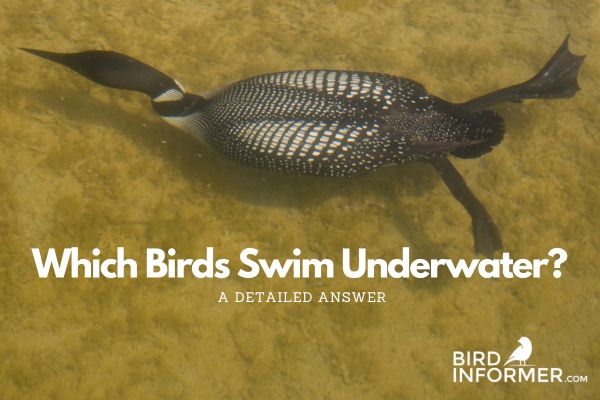Contents
Are you trying to discover which bird that swims underwater? What if I told you that even though it’s rare, there are a number of birds with this ability? If you visit the ocean, grab your scope and binoculars because you may even see them diving into the water right in front of you! Keep reading to learn about the few bird species with the ability to swim underwater.
There are seventeen birds that swim underwater. This is a small percentage since over 10,000 birds exist today. The list includes loons, puffins, terns, diving petrels, boobies, penguins, geese, American dippers, grebes, gannets, diving ducks, cormorants, coots, swans, anhingas, pelicans, and shearwaters.
Would you like to know more about these majestic birds in greater detail below? I’ll share this important information and other topics that include:
- 17 aquatic birds that can swim underwater
- Swimming birds that also catch fish
- Swimming Bird FAQs
- and more
To discover more about these amazing birds and their incredible aquatic capabilities, please continue reading below.
Aquatic Birds: 17 Birds with the Ability to Swim Underwater
Loons
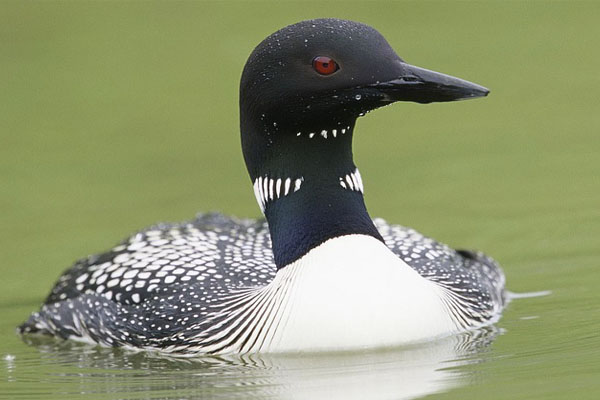
On a quiet lake, the loon can make its distinctive call, which can be heard for many miles. This large bird is an aquatic animal known for its swimming and diving capabilities. They can hunt for fish underwater and can even stay underneath for long stretches of time.
The diving capabilities of loons make it possible to remain submerged underwater for long stretches even when the current is rough. As a matter of fact, they can remain underwater for roughly 5 minutes, which is incredibly impressive.
They have powerful wings that allow them to swim across the water very quickly, while catching fish and other underwater animals that they’ll fly away with after they finish their swim. Besides fish, loons eat other aquatic creatures, including certain insects, crustaceans, and amphibians.
Puffins
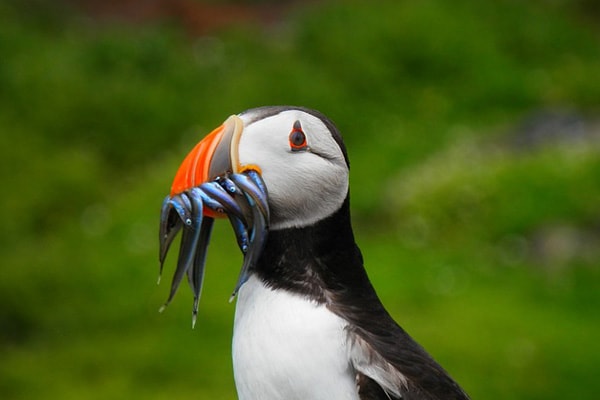
Atlantic puffins are very active swimmers in the late summer and early fall. You’ll discover these beautiful creatures diving deeply into the water from way up in the sky in an effort to catch some fish.
On average, the typical puffin can stay submerged in the water for 20-30 seconds. And these amazing birds have the ability to dive deeply into the water and submerge themselves as much as 197 feet, or 60 m.
Their diving capabilities are short, but this bird can swim underwater for very long distances. It’s wings make for efficient petals, which allow it to hunt for prey while swimming back and forth under the water.
A puffin will swim to the surface and swallow its prey head first after it catches a fish. Then it takes a quick breath before diving down into the water again in an effort to hunt for another fish.
Terns
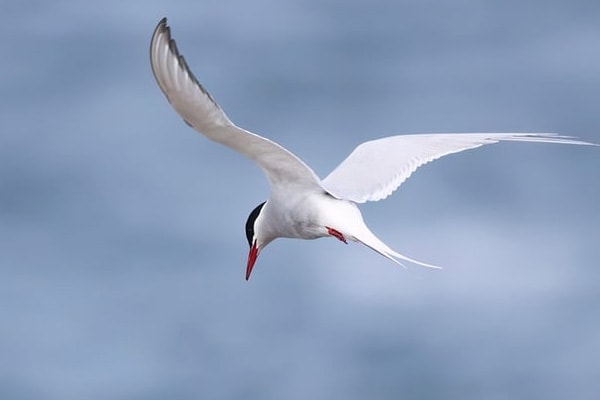
The seabird, known as the Tern, is best known for its slender, long wings. Tern wings typically have white feathers and black markings along the wingspan.
Found on the North American coast on the West Coast and East Coast, these majestic birds can fly quickly and expertly while swiftly diving underneath the water for a few seconds at a time to catch fish.
Typically, the turn will dive underwater and only travel 20 inches. But that isn’t its full capabilities because if the Tern needs to, it can travel 3 feet underwater when the time is right.
Did You Know That The Tern Is Known For Its Long Distance Migration?
Click the button below to read about the Artic Tern and other impressive migratory birds!
Diving Petrels
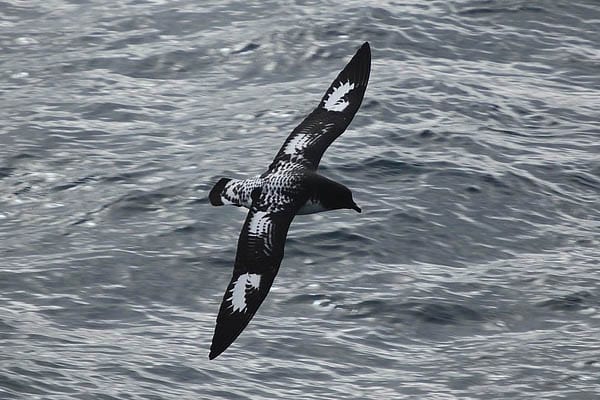
The majestic seabird known as the diving petrel has the rare ability to swim underwater. In fact, this bird can swim underwater and remain submerged for as many as 15 minutes, and sometimes it lasts even longer. It can dive quickly to depths that reach 34 m into the water, which is quite impressive.
The wings of the diving petrel have evolved over the centuries, and they make it easy for this bird to swim. The wings are long and have pointed tips that can quickly cut through the water. This quick swimming skill makes it easy for this bird to forage in the deep waters, which other birds cannot use for food.
Their wings also double as paddles that allow them to move quickly while swimming underwater. In fact, they can swim so quickly that they move 3.73 mph.
Boobies
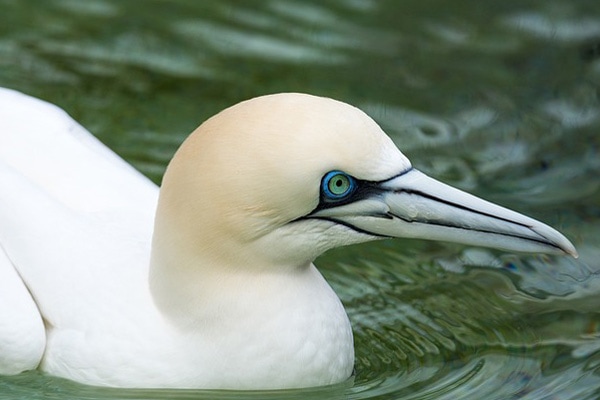
Boobies are incredible birds that not only dive underwater but they can also swim easily within the water and quickly catch prey. Their body and wing feathers have specifically adapted to give these aquatic birds the ability to remain submerged underneath the water for long lengths of time.
They also have pointed, long beaks that make it simple to catch a wide range of aquatic organisms, including squid and fish. Boobies like to hunt in big flocks, which makes it easy for the group to discover their ideal prey underneath the surface of the water.
When they discover an edible delicacy underwater, the booby will dive down deeply and snatch it out of the water before heading back to the surface. Watching these birds dive and swim is a beautiful sight to behold.
Penguins
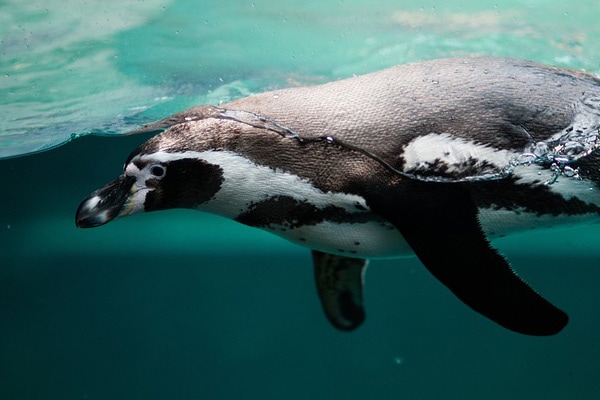
Emperor penguins are truly incredible creatures, one of the few birds that swim underwater. These wonderful aquatic birds can dive and swim underwater for nearly 1500 feet. They can also remain submerged underneath the water on a single breath for as long as 30 minutes. On average, the penguin typically dives and swims below the surface for 18 minutes, going nearly 900 feet downward.
The reason penguins can dive so deeply is because of their adaptations. They have waterproof feathers, a layer of oil covering their skin for drag reduction, and their circulatory system is incredibly efficient. They can conserve large amounts of oxygen underwater for as long as 30 minutes, which is incredibly impressive.
Geese
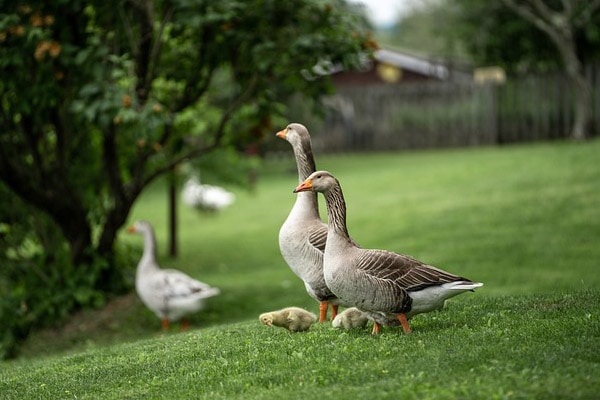
Geese are typically thought of as land creatures, but they can also dive and swim as well. As a matter of fact, a gaggle of geese can dive down for nearly 40 feet and remain submerged in the water for as much as 10 seconds.
Geese have webbed feet, which make them incredibly good swimmers. Their web feet are similar to flippers, because it gives them the ability to cut through the water without much trouble. Nevertheless, these birds also have oil layered across their feathers, which allows them to stay dry even while they are swimming in the water.
The geese respiratory system is powerful and strong, which allows these feathered creatures to dive and swim underneath the water. Their lungs have adapted to give them the ability to use the water to extract oxygen, which helps them stay underneath the water for longer stretches of time.
American Dippers
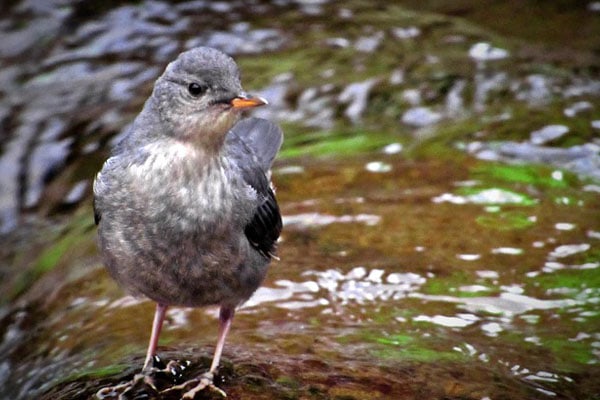
The songbird known as the American Dipper is easy to spot in the western part of North America. More specifically, it hails in Alaska and you’ll find it in parts of central Mexico as well. This bird is commonly found in aquatic areas including ponds, rivers, lakes, and streams.
The American dipper has evolved in a number of ways that make it possible to remain underneath the water for long stretches of time. They have oily feathers, which make them waterproof. They have subcutaneous fat underneath their feathers, which helps to keep them warm while swimming under the water.
They also have webbed feet, which makes gliding through the water an easy task. Combine this with their sharp and pointy bills, and it shouldn’t surprise you to learn that these aquatic birds can catch fish and other aquatic life forms under the water fairly successfully.
Grebes
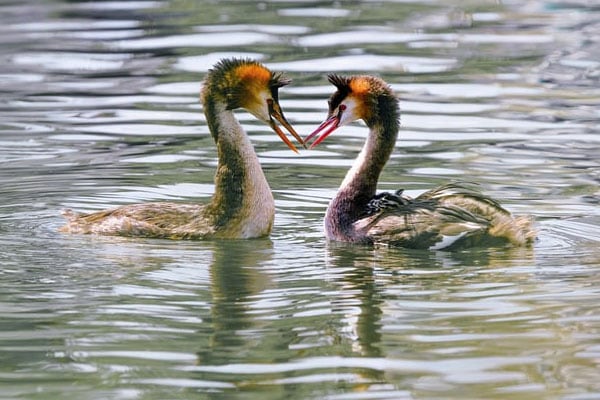
Grebes are seabirds best known for their excellent swimming and diving capabilities. They can dive 20 feet below the surface of the water and stay submerged for around 30 seconds.
Typically, grebes take short dives, but when it’s necessary, they can remain underwater swimming for as long as one minute. This bird has powerful wings that they use to propel them under the water as they move below the surface. Their wings are also beneficial because they help them steer their body while swimming below.
Grebes can also navigate small and tight spaces while searching for aquatic prey to devour as part of the next meal.
Gannets
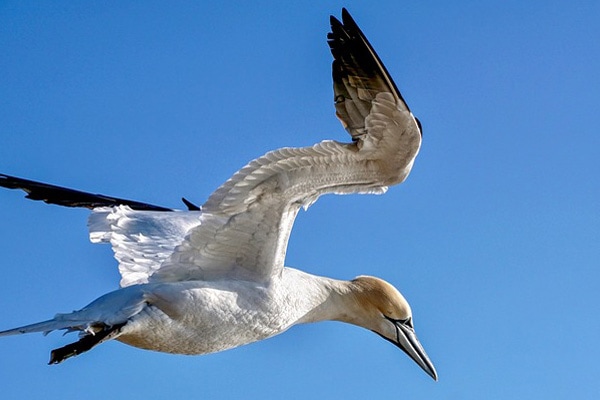
The gannet is a seabird that is well-versed in aerial acrobatics. Besides his beautiful aerial twists and turns, it can also dive down and catch prey below the water. Believe it or not, this bird can stay underwater for quite a while. It can hold its breath for as many as two minutes.
According to birdieexpert.com, “They can reach speeds of up to 90 mph when flying, and their long wings allow them to glide for long periods of time.” These same long wings allow them to swim for long periods of time underneath the water, because their power propels them forward until they finally catch their fishy prey.
Oddly enough, these diving birds aren’t the most successful when it comes to catching underwater prey. In truth, they usually succeed one out of three times, which isn’t the best percentage by any stretch of the imagination.
Diving Ducks
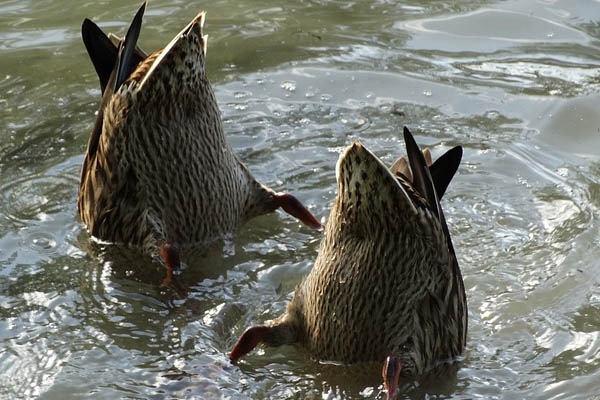
Diving ducks make it their mission to swim underneath the water in an effort to find food. They have the ability to hold their breath for quite some time. In fact, they can usually hold their breath for 10-30 seconds, but when necessary, they can remain under the water for a minute or more while hunting down important prey.
According to ducks.org, “A typical dive takes 10-30 seconds, but diving ducks may remain underwater for a minute or more.”
Believe it or not, diving ducks even have the capability of closing off their nose and ears. This allows them to swim underwater for longer lengths of time if they feel the need to do so.
Since ducks have webbed feet and oily feathers, they are the perfect bird species for swimming under the water while looking for their favorite fish species to eat.
Cormorants
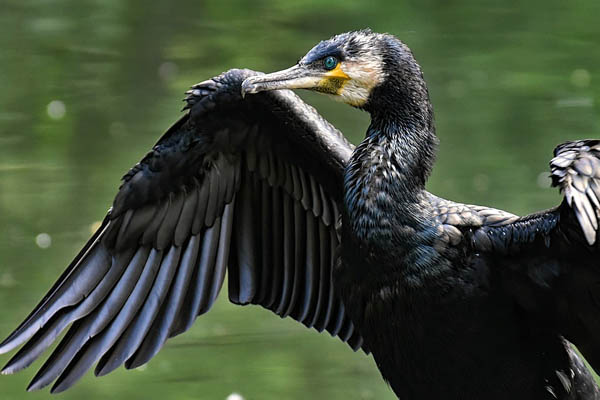
Cormorants love to dive and they have little difficulty catching tasty meals underneath the water. These birds of an aquatic nature can remain underwater for 30-70 seconds on average. They typically dive roughly 150 feet below the surface.
Their powerful wings propel them forward quickly and allow them to swim as smoothly as possible as they cut through the water. Their webbed feet are also a major boon to their swimming capabilities. They even have tails that they use for steering.
After discovering their prey, they quickly dive down into the water and snatch their prey in a swift motion. In fact, they swallow their prey whole underneath the water. They can do this without even coming up for more air.
Coots
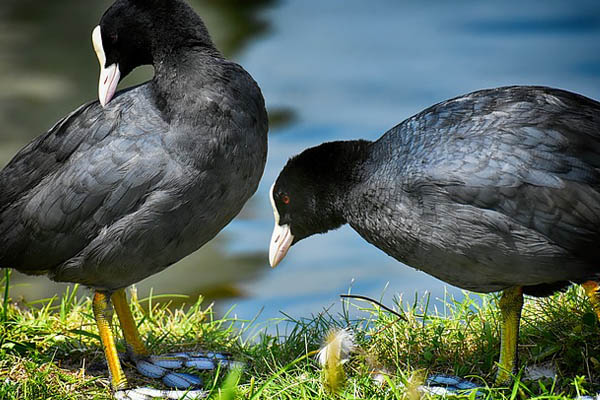
This black, small aquatic bird lives near the water in Eurasia and North America. It is adapted throughout the years to become a perfect diver and swimmer. In fact, it typically stays submerged in the water for 15 seconds or more.
When Coots dive, they can dive down into the water nearly 25 feet. Their webbed feet act as propellers to help them cut through the water and swim sharply to catch fish easily that attempt to break away from them.
Their quick and efficient swimming makes it difficult for other animals to catch them as they are zigging and zagging through the water.
Swans
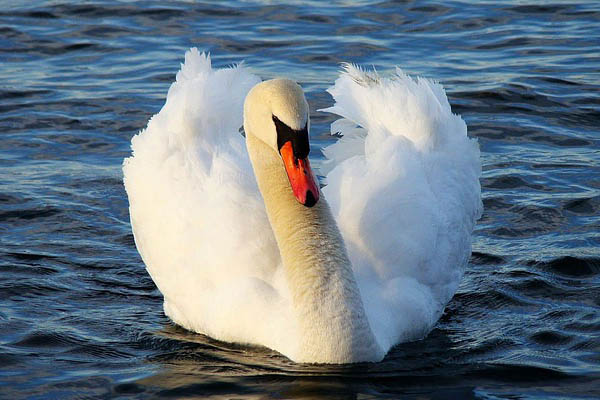
Swans are beautiful birds that are best known for their graceful ability to swiftly glide across the water. But these versatile creatures can do more than glide on top of the water. They can actually swim underwater when necessary. But for the most part, when one is in water, it is typically found floating along the top, not diving underneath.
This doesn’t change the fact that swans can dive. Occasionally, when they need to evade predators or catch food, that’s exactly what they’ll do. They will tuck their heads and necks and submerge themselves underwater and push down using their powerful legs to move forward.
Swans have long necks, as we all know, which gives them the ability to store additional oxygen. A swan can dive under the water and remain comfortably oxygenated for 20 minutes before the need to break the surface of the water and catch another breath.
Anhingas
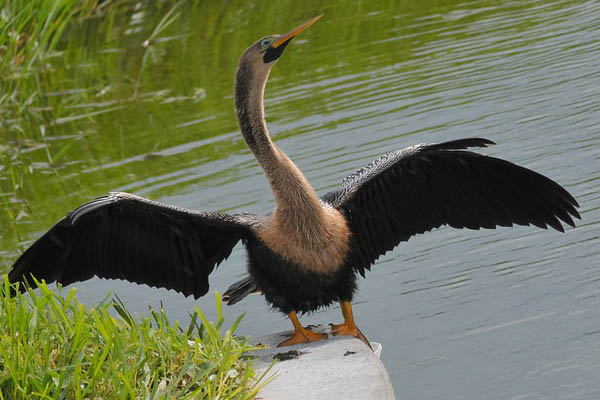
Many bird species aren’t capable of diving underneath the water and swimming while holding their breath for a minute straight. But this bird can accomplish both of these tasks in an effort to find a tasty meal while searching for food. They can dive into the water and swoop down for 60 feet or 18 m.
This bird is evolved to adapt to its surroundings, which gives it the ability to stay submerged in the water for long stretches of time. It’s flexible neck, webbed feet, and strong wings give it the ability to propel itself under the water while searching for prey using its long and flexible neck.
Unfortunately, the feathers of anhingas aren’t waterproof and they do not have a subcutaneous layer of fat, so they get cold quickly and need to return to the surface faster than ducks or pelicans.
Pelicans
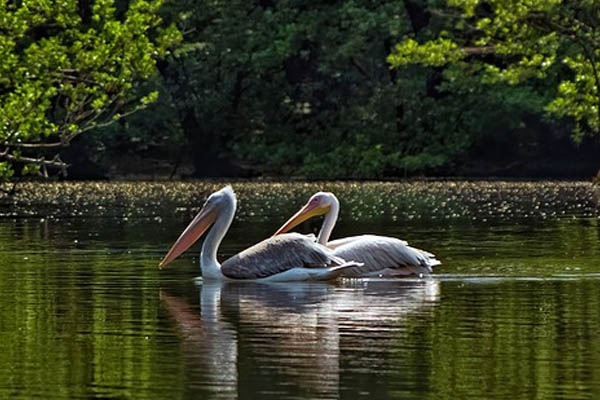
Pelicans have specially adapted lungs that give them the ability to swim underneath the water for long stretches of time. Their lungs are lobed, which is really impressive, and it gives them the opportunity to inhale more air.
The additional air allows pelicans to stay underwater for 20 minutes per diving session. Additionally, pelicans have a layer of subcutaneous fat underneath their skin. This gives them the ability to remain warm in freezing water, which makes them an incredible aquatic bird, to say the least.
Not only that, but American way pelicans are excellent swimmers and can dive 100 feet below the water. This makes it easy to find crustaceans and fish, and other aquatic animals while hunting for food.
Shearwaters
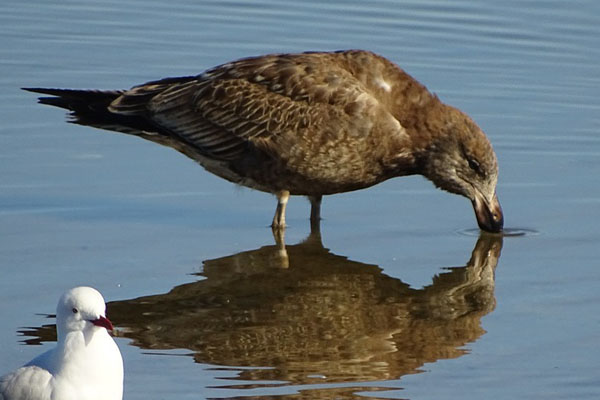
Shearwaters can swim 230 feet below the surface and they are excellent divers as well. Even more important, they can hold their breath for 15 minutes, which gives them the ability to find fish and other prey underwater without having to return to the surface.
Their wings are adapted to act as highly efficient petals. They can propel their bodies through the water with little difficulty. Other adaptations include a large oil gland. This gland allows them to remain warm in freezing temperatures under the water. Their brain also stays oxygenated via air-filled cells due to pneumatization.
Swimming Birds That Catch Fish
| Swimming Birds That Catch Fish | Favored Fish Prey |
|---|---|
| Loons | Small Trout, Shiners, Suckers, Yellow Perch, Crayfish |
| Puffins | Herring, Cod, Sprat, Sandlance, Hake, Capelin |
| Terns | Shrimp, Leeches, Marine Worms, Small Squid, Fundulus, Clupea |
| Diving-Petrels | Crabs, Shrimp, Plankton, Squid, Small Fish, Krill |
| Boobies | Mackerel, Sardines, Flying Fish, Anchovies, Squid |
| Penguins | Cod, Anchovies, Mullets, Sardines, Lantern Fish, Pilchards, Sprats, Silverfish |
| Geese | Minnows, Tiny Fish (mostly herbivore) |
| American Dippers | Worms, Mosquitoes, Midges, Mayflies, Fish Eggs, Tadpoles, Amphipods |
| Grebes | Cod, Goby, Herring, Perch, Pipefish, Minnows |
| Gannets | Menhaden, Smelt, Mackerel, Herring, Capelin, Pollack |
| Diving Ducks | Guppies, Graylings, Minnows, Frogs, Worms, Fish Eggs |
| Cormorants | Sandlance, Atlantic Cod, Rocket Gunnell, Cunner, Sculpins, Flounder, Tautog |
| Coots | Prawns, Crayfish, Worms, Tadpoles, Snails, Fish Eggs, Small Fish |
| Swans | Mollusks, Worms, Tadpoles, Frog Eggs, Fish Eggs |
| Anhingas | Shrimp, Crayfish, Snakes, Pickerel, Mullet, Catfish, Sucker |
| Pelicans | Yellowfish, Rainbow Trout, Grass Minnows, Mullet, Herring, Perch |
| Shearwaters | Squid, Sandlance, Octopus, Shrimp, Anchovies, Dragon Fishes |
Swimming Bird FAQs
Below are a few common questions and answers regarding swimming birds. Pay close attention to get the best answers to your favorite questions about these aquatic creatures.
What bird can fly and swim underwater?
There are a number of birds that have the ability to fly and swim under the water. A quick list of some of the more popular birds with this ability include:
- Puffins
- Cormorants
- Diving Ducks
- Coots
- Geese
- Pelicans
- Grebes
- Swans
- Loons
- Penguins
What bird can stay underwater for 20 minutes?
Believe it or not, there are three birds that have the ability to remain underwater for 20 minutes or more. The birds with this incredible breathing capability include:
- Penguins
- Swans
- Pelicans
Out of the three, Penguins can actually remain underwater for as many as 30 minutes. Swans have long necks that hold extra oxygen, which gives them the ability to remain underwater for a solid 20 minutes without running out of breath. And pelicans have lobed lungs, which grant them the ability to hold extra air that they can use to oxygenate their body while swimming underwater for 20 minutes at a time.
Which bird lives in water?
Technically, these birds aren’t actually fish. They do not have the ability to live underwater because they cannot breathe underwater. But there are a number of birds that are considered aquatic birds or waterbirds. These ducks, swans, geese, grebes, pelicans, and other bird species are on the water regularly, and they dive and swim underneath the water to catch fish and other amphibious prey.
What bird can swim underwater the longest?
While some birds can remain underwater for five minutes, 10 minutes, or 15 minutes or more, the Emperor penguin is the singular bird with the greatest ability to stay underwater the longest.
How long can it swim underwater? This penguin can remain underwater without taking its head up to catch a breath for 30 minutes. This is an additional 10 minutes longer than swans and pelicans can remain underwater.
It’s truly an amazing sight to behold. But Penguins were born for the water, and the unique physiology makes it possible for them to go underwater and remain warm, healthy, and full of breath for 30 minutes. Although, a typical penguin dive usually lasts only 18 minutes.

